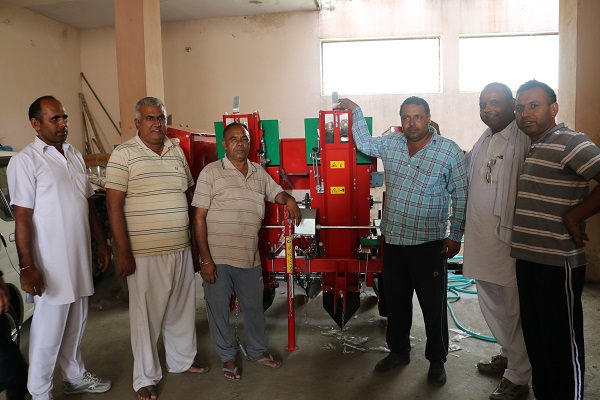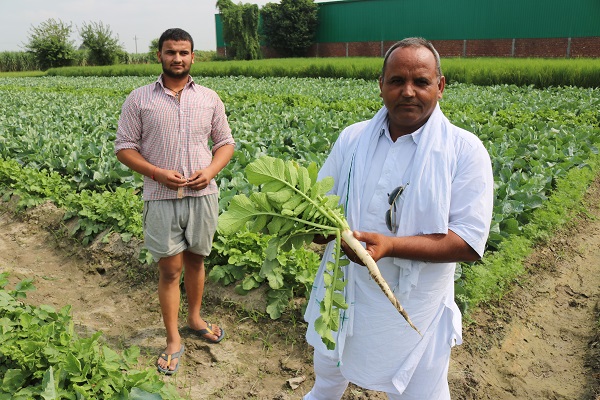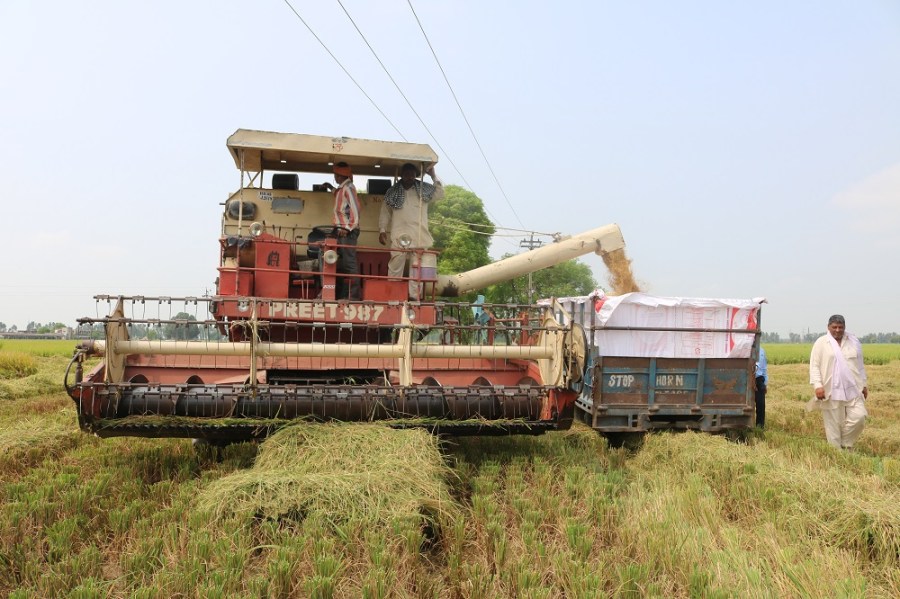India’s farming communities create a thriving rural hub for exchange of ideas. But a lack of applied research and infrastructure challenges may hold back the country’s agriculture. CPM finds out on a special farm tour, organised by BKT.
Farmers here thirst for new ideas and better ways to farm.
By Tom Allen-Stevens
As we walk down the village street, the level of chit-chat from the group of 22 farmers seems to intensify. The noise stirs a cow that’s tethered at the side of a barn and it lumbers to its feet to give the group a slow stare.
With a certain amount of ceremony, the barn doors are then flung open, and there inside is Rajender Singh’s brand new purchase – a two-row Tiger potato planter. It’s only recently been delivered, but is set to plant more than just the few hectares he’ll grow himself this winter. It’ll plant the potatoes for the whole community.
The group calls itself the Hi-tech Vegetable Growers Association. Individually they each farm on average about 20ha, centred around the village of Phoosgarh, just outside Karnal in the fertile Haryana state of northern India. But everything is pooled – from labour, to machinery and most importantly, so are the ideas. This is true communal farming and Rajender Singh, for example, needs no contracts to know he’ll get a decent amount of work and a return on his $2000 investment, that’s subsidised by the Government.
“We like to use the best of new methods and new technologies – this is more than just ‘jugaad’,” explains Gulzari Lal, who’s the leader of the group. ‘Jugaad’ is a colloquial word that encompasses anything innovative or non-standard. It illustrates the Indian resourcefulness that bends rules to overcome a problem or complicated issue.

Rajender Singh (third from right) with his brand new potato planter, that’ll be used to plant the crop for the entire community.
“We are striving to improve our yields and our productivity,” continues Gulzari Lal. “We don’t want to be slaves to government subsidies. So we’re using the best technology and ensuring the next generation has the best education.”
The tour of the Indian farms has been organised by tyre manufacturer BKT. But the company’s representatives who come to the farm bring more than just tyre technology to the fields. “Farmers here thirst for new ideas and better ways to farm,” says BKT’s Amandeep Singh Mehandru, who’s acting as tour guide and interpreter.
“But extension services are not as well developed as they are in Europe – there’s a lack of knowledge transfer from research level into the fields. BKT employees are actively supporting farmers in this regard, although not directly.
“We help by informing farmers about the various exhibitions on modern farming techniques which they can visit and also give them access to the agriculture magazines from which they can learn new farming techniques. We currently send nine agricultural magazines to farmers in different regions of India in various regional languages.”

Gulzari Lal (foreground) and his son grow cauliflower, around which they plant vegetables for personal use.
Representatives from other companies, such as those selling drip-irrigation systems, tractor manufacturers and seed companies do likewise, and BKT is involved with organising common meeting forums for farmers in a particular area where they can help share knowledge. “The way in which farmers work means that once brought in, an idea is quickly adapted and assimilated – the exchange of ideas within a farming community is very impressive.”
The group aims to grow three crops every year across its light, organic soils. The potatoes are rabi crops, which are those grown during the winter months. Planted in Oct, short days and long cool nights help tuberisation, and they’re generally harvested in Dec. These are then followed with a vegetable crop, that’s picked in May.

The 50hp John Deere 5204 is ideal for the work expected of it, and with a weight of just 1.8t, soil compaction is a problem few Indian farmers have ever experienced.
Rice is the main kharif crop, grown during the monsoon months of June through to Oct. “Cropping here very much depends on the weather,” explains Gulzari Lal.
“If conditions are favourable, we will be able to grow potatoes and then a vegetable crop in the winter. If not, we’ll generally grow wheat. Wheat and rice are the two preferred crops because there’s a guaranteed return through the Government’s Minimum Support Price (MSP).”
India is the world’s third largest producer of wheat, after the EU and China, with a harvest of around 90M tonnes – more than North and South America combined. But even this is dwarfed by the size of its rice crop at 106.5M tonnes, with only China producing more. The country needs this level of production – there’s a population of 1.25bn people and this is steadily growing.
But unit productivity is relatively low for the country’s climate and rainfall – wheat average yields sit at around 3t/ha, with rice up at around 4t/ha. Once harvested, there’s very little a farmer can do to influence returns from the crop. The main commodities are tightly controlled by the Government that sets the MSP each year for kharif and rabi crops. There’s very little on-farm storage, and government policy has historically actively discouraged this as it’s perceived as hoarding, which would drive up food prices.
The result is that the commodity crops are taken to market soon after harvest and sold into government storage houses. But even these have come under criticism – a recent report by the Institution of Mechanical Engineers (IME) on global food wastage found this was particularly high in India. Around 21M tonnes of wheat is lost due to inadequate storage and distribution – equivalent to the entire production of Australia.
Gulzari Lal invites us out to the fields to see the crops and mounts a trials bike, his brother riding pillion (neither with a helmet), to lead us there. It’s a short journey, punctuated by the many peeps on the horn from our driver as various obstructions wander into his path – whether that’s a lumbering truck, loaded impossibly high with bulging sacks of straw, or a nonchalant cow, seemingly in full knowledge that its sacred status will keep it safe on the busy road.
Rice is nearing harvest in the field itself, laid out around a network of irrigation channels with vegetables for personal use grown at the field edge. Water – and lots of it – is a major part of production here. Gulzari Lal starts up the pump and there’s soon a small stream heading towards the rice.
“We draw water from around 90 feet (27m) below the surface,” he explains. “There are no restrictions on how much we use and we don’t monitor usage, although rice needs around ten times the quantity of wheat.
“The Government is now encouraging drip irrigation, which can cut your water usage by half. We’ve installed this in some of our fields, but it’s very expensive, and you can’t justify it for commodity crops.”
Rainfall in the area averages around 620mm/yr. About 60-70% of this falls during the monsoon season of July to Sept, while Oct and Nov are typically the driest months.
But it’s irrigation that drives crop growth and which has transformed cereal production in India during its Green Revolution in the final three decades of the last century – the irrigated area tripled to more than 33 million ha.
There’s evidence India’s groundwater may be depleting, however. Satellite surveys that measure subtle changes in the Earth’s gravitational field, often the result of shifting water, have identified north-western India as an area suffering rapid water loss. Farmers report they’re having to draw water from deeper below ground surface to maintain the supply they require.
We set off from Phoosgarh and come across rice harvest in full swing on our way to the next farm. It’s an operation carried out by contractors, and the beat and whine of Hindustani music, strapped to the open-cabbed harvester, almost drowns out the machine itself. But harvest is clearly a community event, and farmer Rajesh Kumar can be found at the edge of the field with a group of other farmers and villagers, monitoring progress and directing the grain carts.
He farms around 40ha in total, and this is the first of his premium rice crop being harvested. “The yield isn’t too bad at around 25-26 quintals/acre (6.2t/ha),” he reports.
“The trouble is, the MSP is too low. I’m hoping the Government will raise it, because at present rice costs us more to grow than we receive.” The MSP for 2016-17 season has been raised about 4% to just over Rs 1500/quintal (£180/t). But the Government, wary of a population easily upset by food inflation, came in for harsh criticism when it dropped the MSP sharply two years ago with little warning. What’s more, Rajesh Kumar complains that the MSP is usually announced too late to influence crop planning.
He too irrigates, and shows us his pump that draws water from as deep as 180m below the surface. His rice clearly receives close attention – the standing crop in the field next door has been trimmed by hand to limit lodging, for example.
As the combine leaves the field and moves into the next one, a group of local women move in to gather fallen heads of rice from the stubble. “But that will be for their own use, not for the grain cart,” explains Rajesh Kumar.
Sugar cane is one of the main crops grown by the Progressive Farmer Society at the next village. This is a group of 50-60 farmers with about 240ha in total. “Our land isn’t suitable for vegetable production – it’s too sandy,” explains head of the group Raj Bir Singh.
“Rice and wheat is an easier rotation, but sugar cane is the more profitable crop.” The group has a total of 80ha of sugar cane, and the MSP currently stands at Rs 230/quintal (£27/t).
Planted in around March or April, the crop stays in the ground for about 18 months, and is harvested twice in Dec each year. “We get a yield of about 300 quintals/acre (74t/ha) at the first cut, then more like 350 quintals/acre (86t/ha) at the second cut.”
India has around 5.3 million ha of sugar cane – second only to Brazil, that has twice this area – and grows around a quarter of the world’s crop. But in terms of productivity, it lags behind with an average yield of 70.9t/ha, close to the global average and almost half the average level achieved in the most productive parts of the world. It’s another water-hungry crop, although not as demanding as rice.
Like the previous farm group, the Progressive Farmer Society has invested in its irrigation infrastructure, with underground pipes now taking water to far-flung fields. “It gives us greater control, as well as reducing the amount we use,” notes Raj Bir Singh.
It’s a labour-intensive crop, however, with planting, weeding, management and harvest all requiring plenty of manual input. Sugar cane grows to a height of over 3m and is prone to lodging. This is minimised through propping, where lower dry and green leaves are bound together by hand to form a sort of rope, with cane stalks tied together. “The crop has to be tied three times a year, and then it’s harvested by hand,” explains Amrik Singh, Raj Bir’s son. “Ten people can harvest one acre (0.4ha) in two hours. It means we’re dependent on migrant labour.”
Amrik Singh’s pride and joy, however, is his tractor. Every farmer in the group owns one, with Indian-owned Escorts Farmtrac or John Deere the favoured brands. At a subsidised price of around $10,500, the John Deere 5204 is a popular model. It pulls just 50hp, which is small by comparison with the 200hp-plus tractors you’d find on a European farm, but ideal for the work expected of it within this farming community – the strength comes in numbers, rather than size. What’s more, with a weight of just 1.8t, soil compaction is a problem few Indian farmers have ever experienced.
Tyre technology gets the attention it deserves, though. “I do a lot of work with this tractor and you need a good set of tyres,” notes Amrik Singh. “You can buy a cheap brand and they won’t last – the lugs are usually the first to go.”
Perhaps unsurprisingly, it’s a set of BKT Farm 2000 tyres he has on his tractor, as do many in the group. But the decision’s not been taken blindly. “I put a lot of research into which tyres to go for – I used the internet, as well as discussing issues with other farmers and getting advice from the BKT representative,” he says.
And communications infrastructure is one area in which this rural community thrives. Every farmer has a smartphone and the mobile signal appears strong wherever you go. Recent studies have shown India’s rural poverty has fallen sharply, and this is attributed to a booming trade in mobile phones and motorbikes. Most farmers in this group have a grasp of the technology that may put many European farmers to shame.
“BKT has the premium tyres,” continues Amrik Singh. “There’s the Commander that has greater comfort on the road or the Farm 2000. I do little road work – durability in the field is my main requirement. But what swung it for me is that the tyres come with a six-year warranty.”
Apart from cultivating, one of the major uses for the tractor is levelling the fields prior to planting. Many growers are now investing in laser-guided land levellers, especially where vegetables are in the rotation. But Amrik Singh points out the kit he uses – little more than a tree trunk on chains. “Sometimes the older equipment works just as well,” he says.
The final stop is the village of Dhirpur, where the set-up is slightly different. There’s less of a community-farming approach, with land tenure closer to a European system of owned and contract-farmed holdings. The cropping, soil type and production levels are fairly similar to the previous farms, but there’s less optimism in the future.
“We’re stuck with the Government, and where it sets the MSP, and the middlemen [local commissioning agents] to determine what we receive for the crop,” notes Gurmail Singh, who farms a total of 13ha.
“Production levels haven’t risen since the Green Revolution, but our costs are rising, and the next generation don’t seem to want to become farmers, so there are no new ideas coming in.”
So what about knowledge transfer – how do they access applied research? But the question comes straight back. “How do you access new ideas? I’d like to know,” he says.




